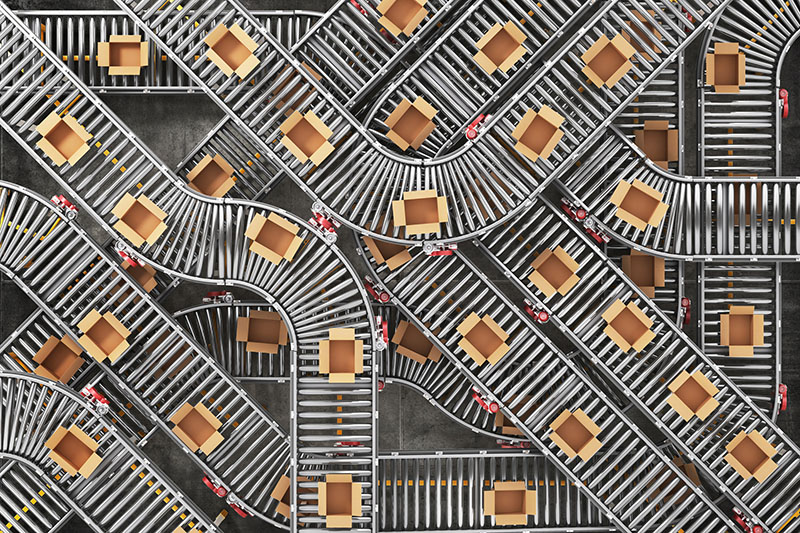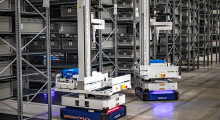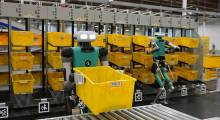The headline in the weekend Wall Street Journal caught my eye. “More Online Shoppers Are Taking It Offline.” The gist of the article was that pretty much everyone, including the materials handling industry, assumed that in-person shopping was dead in the water. Instead, the Journal reported, “stores are mounting a comeback. … By the fourth quarter of 2021….consumer buying habits [were] roughly back to their prepandemic trend.”
Now, the prepandemic trend was a steady march towards more and more e-fulfillment, but the statement we heard over and over – that in five months, the pandemic accelerated that pace by fiver years, and there ain’t no goin’ back – may need to be tempered. A few data points from the reporters:
March was the first month since November 2013 to record a year-over-year drop in e-commerce sales, when they dropped by 3.3% from March 2021. Meanwhile, brick-and-mortar sales rose by 11.2%.
Dick’s Sporting Goods saw online sales fall 11% in its most recent quarter; Best Buy’s online sales dropped 12%; still, both retailers reported an overall increase in sales.
Amazon posted a $206 million operating loss for the 4th quarter of 2021 and a 1% drop in revenue at its online stores. Amazon!
Now, I don’t think we’re all going to go racing back to stores for everything, given the convenience of shopping online. But it made me wonder how the dynamism of this market might impact the implementation of micro-fulfillment centers, or MFCs. Those are defined as those systems put in 5,000 to 10,000 square feet in the back of a grocery store or big box retailer; or facilities ranging from 5,000 to 50,000 square feet located in empty store fronts or purpose-built facilities near urban areas?
Two other data points provide a part of the answer: The same WSJ article noted that Walmart has plans to build around 100 small, automated fulfillment centers attached to existing stores in the next few years to make room in the aisles for those in-store shoppers rather than have employees clog the lanes to fill e-commerce orders. However, another article in my local New Hampshire paper reported that Amazon had canceled plans to build an e-commerce fulfillment center in the state, part of an increasing trend of people protesting against plans to build fulfillment centers of any size in their communities due to the additional traffic, noise and lights associated with the facilities. NIMBY comes to warehousing.
So, what’s really going on? To find out, I spoke to Rowan Stott and Reuben Scriven, who are analysts at the research firm Interact Analysis. Back in March, Stott published a report that forecast a total of 7,300 automated MFCs to be installed globally by 2030, with half of those within the Americas – the US still leading the way. Sounds impressive, but he noted that the rollout of MFCs was slower than previously expected “due to a range of both supply-side and demand-side factors.” In other words, it isn’t all about the problems in the supply chain.
On the supply side, Stott reported that 60 systems were on order going into 2021 but only 43 were installed globally. What he wrote about the demand side made more of an impression: “On the demand-side, we’ve seen a little hesitancy in the market to roll out automated MFCs at scale. As part of our research for both the 2021 and 2022 edition of this report, we spoke with several grocers and the sentiment towards automated MFCs has decreased somewhat, although most cited this decline in sentiment on the basis that they’ve not seen their peers roll out MFCs at scale, resulting in a chicken & egg scenario. Another factor has been the phenomenal growth of rapid delivery companies.”
In other words, while everyone is waiting for their competitor to go first to see whether it makes a difference or they fall flat on their faces, there are more and more rapid delivery options available, which presumably could make MFC’s unnecessary. Note that his research was conducted in 2021, before some of the slowdown in e-commerce we’re seeing now.
In an interview, Scriven and Stott pointed out that while a number of retailers have rolled out some kind of in-store fulfillment option, most of them are manual. Best Buy, for instance, is dedicating up to 50% of the space in some of its stores to fulfillment, and “right now, the stores are fully manual,” said Scriven. He identified a grocer that had put in an automated MFC back in 2019 to pilot the concept and is now back to manual fulfillment.
Two challenges: Getting an ROI and servicing the MFCs. “The ROI is dependent on how productive your manual picker is,” said Stott. “If you have productive pickers, it’s harder to get the ROI from automation. Many retailers are taking steps to improve productivity of manual pickers in the store” rather than to implement automation.
As to service, someone has to maintain the MFCs, and that probably isn’t going to be the high school kids or retirees who predominate the grocery store work force. “We believe there is going to be an opportunity to generate service revenues because your inhouse labor is store associates,” Scriven said. “But, to do that, they’ll have to introduce a lot more predictive maintenance into their systems and do more preventative maintenance.”
They also identified another development that could render MFCs unnecessary, which is Instacart. The e-fulfillment and delivery company was initially seen as a fast and cheap way for grocers – and now other retailers – to jump into the order-online/ship to home market; then Instacart was viewed as a threat because the company owned the customer relationship and data.
Now, according to the pair, “Instacart is building out a network of automated MFCs with Fabric to house inventory on behalf of grocers so its own investments may off-set the potentially reduced number of facilities installed by grocers.” If I understand the model correctly, Instacart’s MFCs would essentially be small 3PLs located near customers to provide fast, home delivery for a variety of customers. Some inventory could be evergreen and used for all customers – Cheerios, after all, is Cheerios regardless of what grocer or convenience store you buy it from – and private-label or chain-specific inventory could be managed like inventory in any other 3PL.
“When we did our research in 2020, everyone talked about Insta as the monster grocery had created,” said Scriven. “They had an inexpensive CapEx solution, but Instacart owned the data. Today, the story has transitioned 180 degrees. I wouldn’t go so far as to say that no grocer will want their own MFC, but, if Instcart is successful, the grocers will own their own data; Instacart will provide the order management platform, and Instacart can pool labor resources across all of the customers in their MFCs.”
I think it goes without saying that some of the largest retailers, like Walmart, will invest in automation wherever it makes sense, including in MFCs. But for grocers and retailers without the scale and resources of the industry giants, I’ll be watching those instore traffic versus e-commerce sales numbers over the coming months. The future of MFCs may depend on them.
About the Author
Follow Robotics 24/7 on Linkedin
About the Author
Follow Robotics 24/7 on Linkedin
Article topics
Email Sign Up
















